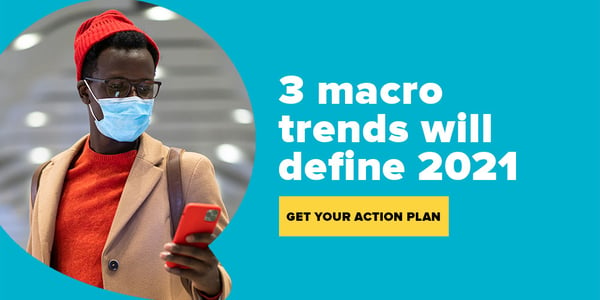Businesses need to develop a holistic understanding of their customers to know how best to provide the choice and control consumers seek.
Over the past ten months, a lot has been said about how Covid is reshaping our economy, our politics and our way of life. And that’s all true. But arguably the most fundamental shift taking place right now is the one inside our heads.
Stanford neuroscientist David Eagleman has been researching and writing about the dynamic nature of our brains for over a decade. The sole purpose of the brain, he said In a recent Economist podcast, is to create an internal model of our surroundings—and Covid, given the unfamiliar ways in which we’ve had to respond to this threat, has fundamentally rewired our brain: “Our internal models, for the first time in our lives, aren’t working so well. Suddenly, the pandemic comes along and we’re knocked off our hamster wheels.”
Time to reinvent the wheel
While that sounds bad, getting our brain “to do a bit of extra work” is actually a positive in the long run: Falling off that hamster wheel helps us to stave off dementia, he notes, as well as to challenge outmoded behaviors and attitudes. “In order to keep change happening in the brain, you have to put yourself in novel situations. The pandemic is something that happened to us, but there are a million things to learn (from it).”
Behavioral heuristics that consumers have relied upon for years are suddenly being updated with new COVID-influenced inputs.
For marketers, this rewiring is forcing us to re-evaluate how consumer attitudes, behaviors and routines have changed, and continue to change, in the wake of Covid. Behavioral heuristics that consumers have relied upon for years are suddenly being updated with new COVID-influenced inputs, and as a result marketers must also update their strategies. This new world order requires new ways of engaging and communicating with consumers—on a continuous basis—to truly understand what is motivating these shifts.
Throughout 2020, Reach3 Insights conducted ongoing research with U.S. and Canadian consumers, using our conversational, mobile messaging-based techniques to capture the pulse of a dynamically evolving population.
One of the key findings? That people, more than ever, are looking to get back to basics. Consumers are “reprioritizing food, water and home essentials, as well as safety, hygiene, wellness and cleanliness,” according to our recently released 2021 CMO Playbook, with 52% of participants saying they are doing more self-care during Covid and 48% saying they are doing “new or different types of physical activities.”
Perhaps no brand exemplifies the consumer shift to choice and control in self-care better than Peloton. In the early months of the pandemic, as everybody sheltered in place, fitness buffs looked for alternatives to shuttered gyms and cycle studios. The eight-year-old home exercise company was one of the immediate winners—with Peloton’s revenue rising 66% in the first three months of the year, and the company ending the quarter with a backlog of deliveries. At over $2,200 USD a bike—plus $39 a month for live-streamed classes—the Peloton system isn’t cheap, but it’s fair to say that many people who made the investment won’t be going back to the gym anytime soon.
Listen to consumers—and let them choose
Another big change has been in the entertainment business. During the pandemic, consumers sought out the distraction of entertainment—movies, music, comedy shows—from the comfort of their homes. Some forms of “bums in seats” entertainment—like live music or theater—will ultimately come back, once the pandemic is under control, but the shift toward digital is looking increasingly permanent for film: in early December, movie producer Warner Bros. announced that all of its 2021 releases would appear simultaneously on HBO Max and in theaters.
“What we’re doing here is giving fans choice, which they haven’t had, and I think that’s a really powerful thing,” WarnerMedia CEO Jason Kilar told podcaster Kara Swisher.
The move accelerates a trend that’s been happening for years as consumers seek greater choice and control in their entertainment consumption. But if other movie producers follow Warner’s lead, what will compel consumers to get off their sofas and watch the latest blockbuster, side by side with strangers, ever again? Even when the “danger” sign stops flashing in our brain and we feel comfortable enough going back into theaters, cinema operators will need to offer a compelling value proposition. The past few years have seen an explosion of theaters serving meals, alcohol and seat-side service—like the successful Alamo Drafthouse chain—but going forward, that “movie night experience” will be table stakes for those hoping to stay in the game.
In a post-pandemic world, businesses that hope to survive and thrive must do three things above all else:
1. Capture a complete and continuous understanding of your customer—not just what they buy, but also the emotions and contextual dynamics driving all of their behaviors. What is true of customers now isn’t necessarily true a month from now—never mind a year from now. Businesses need to invest in continuous consumer insight solutions (like mobile communities) that enable this ongoing understanding. Highly effective and innovative market research techniques are available today that leverage both statistical rigor and immersive video so that brands can truly get inside the hearts and minds of their consumers.What is true of customers now isn’t necessarily true a month from now.
2. Have superior fluency in the digital experience. In addition to optimizing e-commerce experiences, using technology to deepen relationships with customers and potential customers throughout the buying cycle. That could include more digital and touchless ordering capabilities, as we’ve seen in restaurants and retail, but also e-newsletters with exclusive insights and offers, compelling social media content, or virtual showrooms. Now more than ever the future “path to purchase” is digital.
3. Adopt a “helper” mindset. While consumers continue to actively figure out new routines and habits on their own, they also are looking for ideas. Creative brands can serve as helpers in this process, and in doing so build new customer relationships based on trust that can outlast the pandemic. Zoom “helped” many people with work and school in the early days of the pandemic, and this goodwill has led to sustainable commercial success.
Businesses need to develop a holistic understanding of their customers to know how best to provide the choice and control consumers seek. Offer a customer experience that allows people to interact with you however they want—watch your movie at home or in the theatre; visit the virtual showroom or the real thing; eat in or take out—but make sure to continuously monitor and analyze what’s driving those decisions.
As Warner’s Jason Kilar put it—explaining his decision to offer movies across multiple channels in 2021, but also succinctly summarizing 2020: "Life is hard enough. Why don’t we make things as simple as possible for customers?"
To learn the macro trends emerging from the COVID-19 pandemic, check out the 2021 CMO Playbook.

Matt Kleinschmit
CEO and Founder, Reach3 Insights








.webp?width=65&height=83&name=A-LIGN_HIPAA%20(1).webp)

